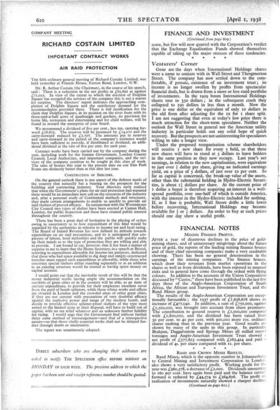UNION 'CORPORATION STRENGTH
The accounts a the Union Corporation do not tell us what proportion of the total income is derived from investments and how much from capital profits from share dealings. Last year, one imagines, it cannot have been easy to make large profits in the Kaffir market, but nevertheless, this mining- finance house has succeeded in maintaining its net income around the record level of £685,o44 set up in 1936, and in maintaining the 68 per cent. dividend rate. Moreover, de- spite the depreciation in Kaffir share prices, the Corporation's holdings of shares, debentures, &c., which represent roughly one-third of the total assets of over £8,00o,000, are still carried in the balance-sheet at a figure substantially below their market value. That is a strong position, and with its interests extending beyond the proved gold-producers, such as East Geduld, into gold mines, such as Grootvlei and Van Dyk, just about to enter the production stage, and base metal and diamond shares, the Corporation is entitled to claim high investment status for its shares. They are of I2S. 6d. de- nomination, yielding nearly 6 per cent. at the current price of z45s.—a sound holding.
I like the statistical survey which accompanies the report, and in present conditions one may draw comfort from some of the facts which it brings out. For example, the British Empire produced 55.6 per cent. of last year's record gold out- put of 35,5oo' 000 ft= ounces and over 8o per cent. of the gold in central banks and Treasuries, as well as nearly the whole of the gold in Exchange Equalisation Funds, is held by six of the great democracies. Welcome as it must be to the Reichsbank, Austria's £ro,000,000 scarcely alters at all this position. Last year, the Corporation's statisticians tell us, the amount of gold in Western boards and Exchange Equalisation Funds showed little net variation at something over 100,000,000 fine ounces (or the equivalent of roughly £700,000,000 at current prices). As everyone knows, 1937 witnessed both hoarding and de-hoarding movements on a very large scale and, in the spring and early summer, a gold
(Continued on page 61o)
FINANCE AND INVESTMENT (Continued from page 609.) scare, but few will now quarrel with the Corporation's verdict that the Exchange Equalisation Funds showed themselves capable of taking up the major stresses of these tendencies. * * * *















































 Previous page
Previous page